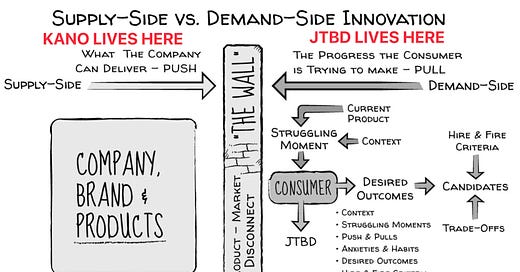Both Jobs-to-be-Done (JTBD) & the Kano model are essential additions to a builder's toolkit. When you first explore them, they feel very similar, almost interchangeable.
JTBD & Kano complement each other, but they're not interchangeable. Let me explain.
What JTBD & Kano share is that they are both lenses on understanding what people value.
Where they mainly differ is in (1) focus and (2) stability.
Focus
A JTBD is about a person. Kano is about a solution that person might choose ("hire").
A JTBD focuses on a person and the progress they're trying to make in a given context. JTBDs live in the person, not in the solution.
The Kano model describes how someone evaluates the current set of options they can hire for their JTBD. Kano lives in the solution, not the person.
In the language of supply and demand, JTBD is about demand, whereas Kano is about supply. See the graphic below from Bob Moesta's excellent Demand-Side Sales 101.
Stability
JTBDs are much more stable and enduring, whereas the attributes of a product that Kano describes change frequently.
For example, consider the JTBD of "I want to go for a long walk and think." The core of that job is stable and has existed for literal ages long time and has many possible solutions someone might hire. Now let's assume that the person wants to listen to music of their choice while they take this walk—that has been possible for at several decades. Let's take the 1979 release of the Sony Walkman as the start of "personal portable music" as a common practice.
Since 1979, different products have been "hired" by consumers with this JTBD. The iconic products were the Walkman, Discman, iPod, and now iPhone. Just two companies dominated these eras: Sony, and Apple. But each of those products—and their competitive sets—had a very different Kano models. The must-haves, performance, and delighter features that satisfy the JTBD are different today when choosing among smartphones than they were in the days of early MP3 players.




